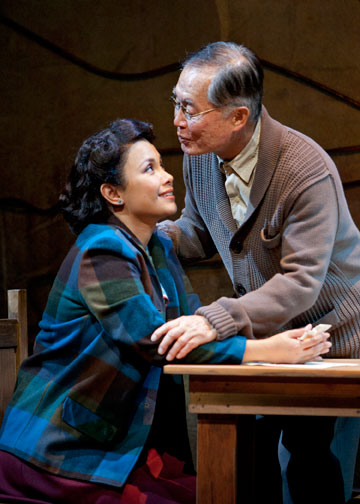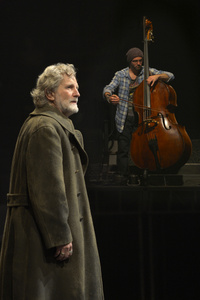Essay: 2012 Not a Great Theatre Year
Let’s face it. 2012 was by no means a great theatre year. Even so, there was good work that went on in San Diego and elsewhere, despite a disappointing overall result.
Maybe it was the economy, maybe it was that some of the local theatres were in transition (the Old Globe was searching for an artistic director, New Village Arts ran into financial trouble, Kathy Bromberger was headed out the door after 35 years at Moonlight, Lamb’s did a season without its resident company, and Seema Sueko needed to find a replacement for someone irreplaceable – herself – after obtaining a major fellowship in Washington, DC). And, what’s up with La Jolla Playhouse, which has announced some major productions (including a re-thinking of the musical, Side Show) but not until June? In the meantime, the Playhouse is filling in with staged readings, bringing back the site-specific Car Plays, and hosting brief visits by Second City and Ben Vereen. About the only theatre that bucked the trend was ion, which acquired the space adjacent to its 49-seat theatre and proceeded to stage a delightful cabaret based on the musical, Chicago¸ there, earlier this month.
I’ve made a last few years’ habit of summing up with a list of the most interesting/exciting theatre I’ve seen this past year, regardless of location. This year, my list would be half-hearted, so instead I’m going to highlight a few positive trends that would include several shows in their wakes.
Trend #1 – The World Premiere Musical in San Diego
San Diego is clearly a good place to produce any kind of theatre, but we’ve been particularly successful in nurturing new musicals. Even so, this year brought a bumper crop of them. And, it wasn’t just the big theatres that got into the act. Several of San Diego’s smaller theatres produced them, and one independent producer rented a theatre to try out a tuner (John Doe: The Musical) that he’d written himself.
The results of these ventures are always mixed, and it is difficult to know how to judge success. If you measure success by being produced on Broadway, only the Playhouse’s Hands on a Hardbody has so far climbed that mountain (assuming it opens, as scheduled, this spring). But, a lot of getting produced in New York is timing, luck, connections, and having the money. Hands was nowhere close to being the best new musical presented here this year, but it was the one that landed the Broadway slot.
One could also judge by audience response. On that score the Old Globe’s production of Allegiance would probably win hands down, as it extended its run and broke house attendance records. But, it also seems that the Globe did a savvy job of marketing this show to audiences, particularly by offering a museum exhibit and part of an art installation along with the performance. The presence of Broadway vet Lea Salonga and George Takei, TV’s “Mr. Sulu,” in the cast probably helped some as well. Allegiance anticipates a Fall 2013 Broadway opening, though it undoubtedly still needs some of that timing, luck, connections, and money to make that projection a reality.
Some of the smaller world premieres were in many ways more interesting. In particular, I liked Nobody Loves You, an Itmar Moses/Gaby Alter project that was sharp, funny, and melodically interesting. It probably needed a bigger space than the White Theatre, but it also probably is too small a project for Broadway. Nevertheless, for me it was one of the highlights of the year. I also enjoyed Diversionary’s Harmony, Kansas, though, despite casting high-quality local actors and an established young director, it probably needed a stronger cast and better direction to succeed. And, the Old Globe’s A Room with a View featured an elegant score and a clever book, but a lackluster production made it forgettable by the end of the year.
Then, there was Yoshimi Battles the Pink Robots, a work I proclaimed the best new musical of the year in my review. It was a spectacular piece of theatre, but one could argue that it wasn’t really “new” – that the Flaming Lips’ material on which it was based had been around and acclaimed for too long to make even the showiest production seem fresh.
It appears that we’ll scale back some on new musicals in the upcoming year, but if reviews are an indicator (and, I wouldn’t be writing them if I believed otherwise), the Globe’s upcoming co-world-premiere production of A Gentlemen’s Guide to Love and Murder will be one for which to buy tickets early.
Trend #2 – The Year of the Director
Not to take away from the toil of hardworking actors and creative team members, but the best and most creative work this year came from directors, both here and elsewhere. Sean Murray, whose seems to be one of the busiest theatre people in town, hit big with a beautifully considered production of Jason Robert Brown’s musical, Parade. Delicia Turner Sonnenberg had a spectacular year, with critically acclaimed productions of A Raisin in the Sun and The Trestle at Pope Lick Creek for Moxie, Topdog/Underdog for ion, and the under-appreciated In the Wake for San Diego REP. Kathy Bromberger went out on a high note with a visually beautiful rendering of Fiddler on the Roof, that production’s Tevye, David Ellenstein, directed a well-wrought production of two Harold Pinter one-act plays at North Coast Rep, and the generally-reliable Robert Smyth did his best work of the year at Lamb’s for See How They Run.
There were some guest appearances that resonated as well. Des McAnuff returned to town to execute an artistic vision that proved to be THE selling point of Yoshimi Battles the Pink Robots, Susan Stroman re-mounted The Scottsboro Boys for the Old Globe and San Francisco’s ACT in stunning fashion, and Lucie Tiberghien gave La Jolla Playhouse audiences a thoughtful and lively production of Blood and Gifts in the Mandell Weiss Forum, a notably difficult space, but one which also served as the venue for two other memorable productions, An Iliad, and In the Red and Brown Water.
I suppose that I shouldn’t call Adrian Noble a visitor, but his third summer as artistic director of the Old Globe’s Shakespeare Festival brought local audiences his distinctive takes on As You Like It, and Inherit the Wind. Mr. Noble will be back next summer, and then we’ll see what happens, given that Barry Edelstein, the Globe’s new artistic director, is a Shakespeare specialist.
Out of town, I thought that Pam McKinnon’s direction of Clybourne Park (at LA’s Taper and later on Broadway) made more of the play than it deserved. She also seems to have struck pay-dirt this fall on Broadway with her production of Who’s Afraid of Virginia Woolf. While visiting New York last summer, I was impressed with Mike Nichols’ direction of a Broadway revival of Death of a Salesman, a production which used the original set designs and incidental music. Also in New York, David Cromer made the difficult play, Tribes, rise above its depressing situation. Later in the summer, Mr. Cromer brought his stunning re-thinking of Our Town to Santa Monica’s Broad Stage with considerable success. I suppose that it would be too much to hope that the Playhouse will engage him to direct its upcoming production of Tribes.
Trend #3 – The Year of the Thought-provoking Play
Those who’ve read my reviews regularly undoubtedly know that I am a sucker for thought-provoking plays, especially ones that can be staged minimally, leaving much to audience imagination. Fortunately, we had several such plays produced locally, and I saw a couple in New York.
Leading the way was the La Jolla Playhouse production of An Iliad, a jaw-dropping re-imagination of the Homer text by actor Denis O’Hare and director Lisa Peterson that served as a wonderful vehicle for former Oregon Shakespeare Festival artistic director Henry Woronicz and his musical collaborator, Brian Ellingsen. The Playhouse also contributed the aforementioned Blood and Gifts, a raw and effective history of the first U. S. involvement in Afghanistan, a history that held lessons for the current U. S. engagement there. Several of the smaller companies always have potential in this area, and the best of what I saw were Intrepid Shakespeare’s An Enemy of the People, Diversionary’s Next Fall, Mo’olelo’s Kita y Fernanda, and three from ion: Topdog/Underdog, The Little Flower of East Orange, and Julia, Claudio Raygoza’s adaptation of Strindberg’s Miss Julie, set in the San Diego of drug kingpins.
In New York, I saw Tribes, a play about the dynamics of being hard-of-hearing, and Cock, which tackled the cultural aspects of sexual orientation as if the relationships involved were staged as a cock fight. We’ll see Tribes at the Playhouse in 2013, and my wish would be for ion to put Cock on its schedule, as the company’s space could be configured as the circular fighting arena that the playwright intended. I think that the ion company would also do a terrific job of producing the play.
The most extraordinary new voice of the season, however, was that of Tarell Alvin McCraney, a protégé of the late August Wilson. The first play of Mr. McCraney’s triology, The Brother/Sister Plays, was staged by the UCSD Department of Theatre and Dance last month. In the Red and Brown Water took its plot from Federico García Lorca’s Yerma but infused it with the spirituality of the Yoruba culture of Central Africa. The result was a vivid tale of poverty and aspiration that won’t soon be forgotten. If you want to see Mr. McCraney’s work, you have two chances to do so. In the Red and Brown Water is still playing at the Fountain Theatre in Los Angeles, after receiving rave reviews, and the second play of the trilogy, The Brothers Size, opens at the Old Globe’s White Theatre in late January.
In a Category of its Own – The Closing Performance of Follies
The original production of Follies was the first show I saw on Broadway, and I have to admit that I didn’t “get” it. I saw it from the last row of the Winter Garden balcony, and while it was spectacular it was also about an era before I was born. With age I’ve come to appreciate both the fantastic score and the structure of the musical as a reflection not only on the follies of trying to recreate an earlier era of one’s life but also the follies of that era, remembered imperfectly.
When the Kennedy Center staged a revival of Follies in 2011, I made sure that I scheduled a DC trip so I could see it. It wasn’t a perfect production, but I wasn’t at all disappointed. Then, the production moved to Broadway for a limited run, and eventually the Center Theatre Group in Los Angeles booked it for a run at the Ahmanson Theatre. As soon as I could, I bought tickets for the closing performance, figuring that, with War Horse coming in immediately after the announced closing date, the tickets I bought would actually be for the closing performance.
In the meantime, I scored a pair of half-price tickets to a Mother’s Day performance at the Ahmanson and was somewhat disappointed. Bernadette Peters, one of the stars of the DC and New York runs, declined to do the show in LA, and the producers had replaced her with Victoria Clark. Ms. Clark is a strong performer, but on Mother’s Day she was still finding her way amongst a cast that had been together for a year. To make matters worse, Elaine Page, the British musical star, was interpreting the iconic “I’m Still Here” differently at each performance, and Mother’s Day was one of her “off” days, in terms of interpretive effectiveness.
[php snippet=1]So, I was more than a little fearful about enjoying the last performance at the Ahmanson, but I needn’t have worried. The cast had jelled, Ms. Clark had “found” both her character and the means to perform the songs beautifully, Jan Maxwell, the other female lead, had her best night of the three I saw, and Elaine Page came through with an interpretation of “I’m Still Here” that blew my socks off (and that’d take a lot of blowing!).
Having seen this performance of Follies, I can die happy.
And, 2000 words into this essay, I see that I’ve highlighted quite a few productions. Even in an off-year, there’s still a lot to remember.
With the economy improving only slowly, San Diego theatres may continue to being averse to take risks. But, there’s enough on the horizon to give me a “glass half full” attitude toward 2013.
See you at the theatre.

In addition to reviewing theatre for San Diego Story, Bill also reviews for TalkinBroadway.com. He is a member of the San Diego Theatre Critics Circle and the American Theatre Critics Association. Bill is an emeritus professor in the School of Journalism and Media Studies at San Diego State University.




I enjoyed your essay.